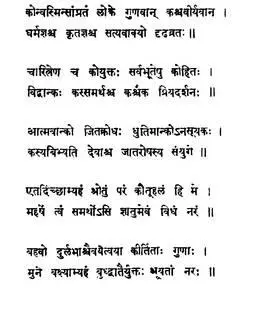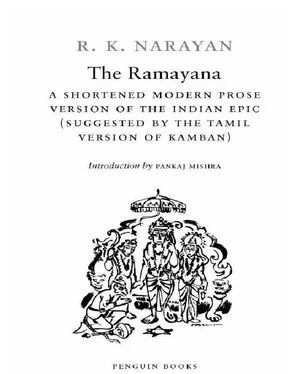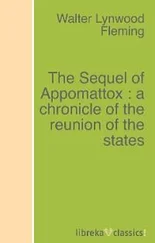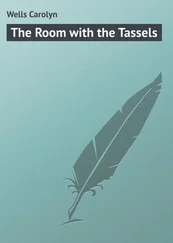Махариши Вальмики - The Ramayana
Здесь есть возможность читать онлайн «Махариши Вальмики - The Ramayana» весь текст электронной книги совершенно бесплатно (целиком полную версию без сокращений). В некоторых случаях можно слушать аудио, скачать через торрент в формате fb2 и присутствует краткое содержание. Жанр: Старинная литература, на английском языке. Описание произведения, (предисловие) а так же отзывы посетителей доступны на портале библиотеки ЛибКат.
- Название:The Ramayana
- Автор:
- Жанр:
- Год:неизвестен
- ISBN:нет данных
- Рейтинг книги:3 / 5. Голосов: 1
-
Избранное:Добавить в избранное
- Отзывы:
-
Ваша оценка:
- 60
- 1
- 2
- 3
- 4
- 5
The Ramayana: краткое содержание, описание и аннотация
Предлагаем к чтению аннотацию, описание, краткое содержание или предисловие (зависит от того, что написал сам автор книги «The Ramayana»). Если вы не нашли необходимую информацию о книге — напишите в комментариях, мы постараемся отыскать её.
The Ramayana — читать онлайн бесплатно полную книгу (весь текст) целиком
Ниже представлен текст книги, разбитый по страницам. Система сохранения места последней прочитанной страницы, позволяет с удобством читать онлайн бесплатно книгу «The Ramayana», без необходимости каждый раз заново искать на чём Вы остановились. Поставьте закладку, и сможете в любой момент перейти на страницу, на которой закончили чтение.
Интервал:
Закладка:
NOTES
1 A. K. Ramanujan, Paula Richman, ed., “Three Hundred Ramayanas,” Many Ramayanas (New Delhi: Oxford University Press, 1992), 46.
2 R. K. Narayan, The Indian Epics Retold: The Ramayana, The Mahabharata, Gods, Demons, and Others (New Delhi: Penguin, 2000), xi.
3 R. K. Narayan, The Ramayana (New York: Penguin, 2006),90.
4 P. S. Sundaram, trans., N. S. Jagannathan, ed., The Kamba Ramayana (New Delhi: Penguin, 2002), 387.
5 Narayan, The Ramayana, 29.
6 Ibid., 109.
7 Ibid., 126.
Books by R. K. Narayan
NOVELS
Swami and Friends (1935)
The Bachelor of Arts (1937)
The Dark Room (1938)
The English Teacher (1945)
Mr. Sampath — The Printer of Malgudi (1949)
The Financial Expert (1952)
Waiting for the Mahatma (1955)
The Guide (1958)
The Man-Eater of Malgudi (1961)
The Vendor of Sweets (1967)
The Painter of Signs (1976)
A Tiger for Malgudi (1983)
Talkative Man (1986)
The World of Nagaraj (1990)
SHORT FICTION
* Dodu and Other Stories (1943)
* Cyclone and Other Stories (1945)
An Astrologer’s Day and Other Stories (1947)
* Lawley Road and Other Stories (1956)
A Horse and Two Goats (1970)
Malgudi Days (1982)
Under the Banyan Tree and Other Stories (1985)
The Grandmother’s Tale and Selected Stories (1993)
* Published in India only
RETOLD LEGENDS
Gods, Demons, and Others (1964)
The Ramayana (1972)
The Mahabharata (1978)
MEMOIR
My Days: A Memoir (1974)
NONFICTION
* Mysore (1939)
* Next Sunday: Sketches and Essays (1960)
* My Dateless Diary: An American Journey (1964)
* Reluctant Guru (1974)
* The Emerald Route (1977)
* A Writer’s Nightmare: Selected Essays 1958 - 1988 (1988)
* A Story-Teller’s World (1989)
* Indian Thought: A Miscellany (1997)
* The Writerly Life: Selected Non-fiction (2001)
* Published in India only
To the memory of my uncle
T. N. Seshachalam
who had steeped himself in
Kamban’s Ramayana, and who expressed
a last wish that I should continue the study
Valmiki the poet explained to Rama himself: “Owing to the potency of your name, I became a sage, able to view the past, present, and future as one. I did not know your story yet. One day Sage Narada visited me. I asked him, ‘Who is a perfect man—possessing strength, aware of obligations, truthful in an absolute way, firm in the execution of vows, compassionate, learned, attractive, self-possessed, powerful, free from anger and envy but terror-striking when roused?’ Narada answered, ‘Such a combination of qualities in a single person is generally rare, but one such is the very person whose name you have mastered, that is, Rama. He was born in the race of Ikshvahus, son of King Dasaratha....’ ” And Narada narrated the story of Rama.

Introduction
The Indian epic, the Ramayana, dates back to 1500 B.C. according to certain early scholars. Recent studies have brought it down to about the fourth century B.C. But all dates, in this regard, can only be speculative, and the later one does not diminish in any manner the intrinsic value of the great epic. It was composed by Valmiki in the classical language of India—Sanskrit. He composed the whole work, running to twenty-four thousand stanzas, in a state of pure inspiration. 1It may sound hyperbolic, but I am prepared to state that almost every individual among the five hundred millions living in India is aware of the story of the Ramayana in some measure or other. Everyone of whatever age, outlook, education, or station in life knows the essential part of the epic and adores the main figures in it—Rama and Sita. Every child is told the story at bedtime. Some study it as a part of religious experience, going over a certain number of stanzas each day, reading and rereading the book several times in a lifetime. The Ramayana pervades our cultural life in one form or another at all times, it may be as a scholarly discourse at a public hall, a traditional story-teller’s narrative in an open space, or a play or dance-drama on stage. Whatever the medium, the audience is always an eager one. Everyone knows the story but loves to listen to it again. One accepts this work at different levels; as a mere tale with impressive character studies; as a masterpiece of literary composition; or even as a scripture. As one’s understanding develops, one discerns subtler meanings; the symbolism becomes more defined and relevant to the day-today life. The Ramayana in the fullest sense of the term could be called a book of “perennial philosophy.”
The Ramayana has lessons in the presentation of motives, actions and reactions, applicable for all time and for all conditions of life. Not only in areas of military, political, or economic power do we see the Ravanas—the evil antagonists—of today; but also at less conspicuous levels and in varying degrees, even in the humblest social unit or family, we can detect a Rama striving to establish peace and justice in conflict with a Ravana.
The impact of the Ramayana on a poet, however, goes beyond mere personal edification; it inspires him to compose the epic again in his own language, with the stamp of his own personality on it. The Ramayana has thus been the largest source of inspiration for the poets of India throughout the centuries. India is a land of many languages, each predominant in a particular area, and in each one of them a version of the Ramayana is available, original and brilliant, and appealing to millions of readers who know the language. Thus we have centuries-old Ramayana in Hindi, Bengali, Assamese, Oriya, Tamil, Kannada, Kashmiri, Telugu, Malayalam, to mention a few.
The following pages are based on a Tamil version of the epic written by a poet called Kamban of the eleventh century A.D. Tamil is a Dravidian language of great antiquity, with its own literature and cultural values, spoken by over forty millions who live in south India. 2
Kamban is said to have spent every night in studying the original in Sanskrit by Valmiki, analytically, with the help of scholars, and every day in writing several thousand lines of his own poetry. Of his task in assimilating Valmiki in the original and reinterpreting him in Tamil verse, Kamban says, “I am verily like the cat sitting on the edge of an ocean of milk, hoping to lap it all up.”

Etched on palm leaves, Kamban’s work, running to ten thousand five hundred stanzas, must have mounted into an enormous pile, as my own copy in a modern edition is in six parts, each of a thousand pages (with annotation and commentaries).
I have taken for my narration several contiguous sections of Kamban’s work. Mine is by no means a translation nor a scholarly study, but may be called a resultant literary product out of the impact of Kamban on my mind as a writer. As a fiction writer, I have enjoyed reading Kamban, felt the stimulation of his poetry and the felicity of his language, admired the profundity of his thought, outlook, characterization, and sense of drama; above all the love and reverence he invokes in the reader for his main figure, Rama—who is presented to us as a youth, disciple, brother, lover, ascetic, and warrior; and in every role we watch him with awe and wonder. I have tried to convey in the following pages the delight I have experienced in Kamban.
Читать дальшеИнтервал:
Закладка:
Похожие книги на «The Ramayana»
Представляем Вашему вниманию похожие книги на «The Ramayana» списком для выбора. Мы отобрали схожую по названию и смыслу литературу в надежде предоставить читателям больше вариантов отыскать новые, интересные, ещё непрочитанные произведения.
Обсуждение, отзывы о книге «The Ramayana» и просто собственные мнения читателей. Оставьте ваши комментарии, напишите, что Вы думаете о произведении, его смысле или главных героях. Укажите что конкретно понравилось, а что нет, и почему Вы так считаете.












